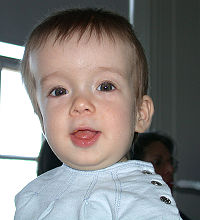
Photo from wikipedia
BACKGROUND Genetic research in nonsyndromic craniosynostosis remains limited compared to syndromic craniosynostosis. This systematic review aimed to comprehensively summarize the genetic literature of nonsyndromic craniosynostosis and highlight key signaling pathways.… Click to show full abstract
BACKGROUND Genetic research in nonsyndromic craniosynostosis remains limited compared to syndromic craniosynostosis. This systematic review aimed to comprehensively summarize the genetic literature of nonsyndromic craniosynostosis and highlight key signaling pathways. METHODS The authors performed a systematic literature search of PubMed, Ovid, and Google Scholar databases from inception until December 2021 using search terms related to nonsyndromic craniosynostosis and genetics. Two reviewers screened titles and abstract for relevance, and three reviewers independently extracted study characteristics and genetic data. Gene networks were constructed using STRING11 analysis. RESULTS Thirty-three articles published between 2001 and 2020 met inclusion criteria. Studies were further classified into candidate gene screening and variant identification studies (16), genetic expression studies (13) and common and rare variant association studies (4). Most studies were good quality. Using our curated list of one-hundred and sixteen genes extracted from the studies, 2 main networks were constructed. CONCLUSIONS This systematic review concerns the genetics of nonsyndromic craniosynostosis, with network construction revealing TGF-β/BMP, Wnt, and NF-kB/RANKL as important signaling pathways. Future studies should focus on rare rather than common variants to examine the missing heritability in this defect and going forward, adopt a standard definition.
Journal Title: Plastic and reconstructive surgery
Year Published: 2023
Link to full text (if available)
Share on Social Media: Sign Up to like & get
recommendations!